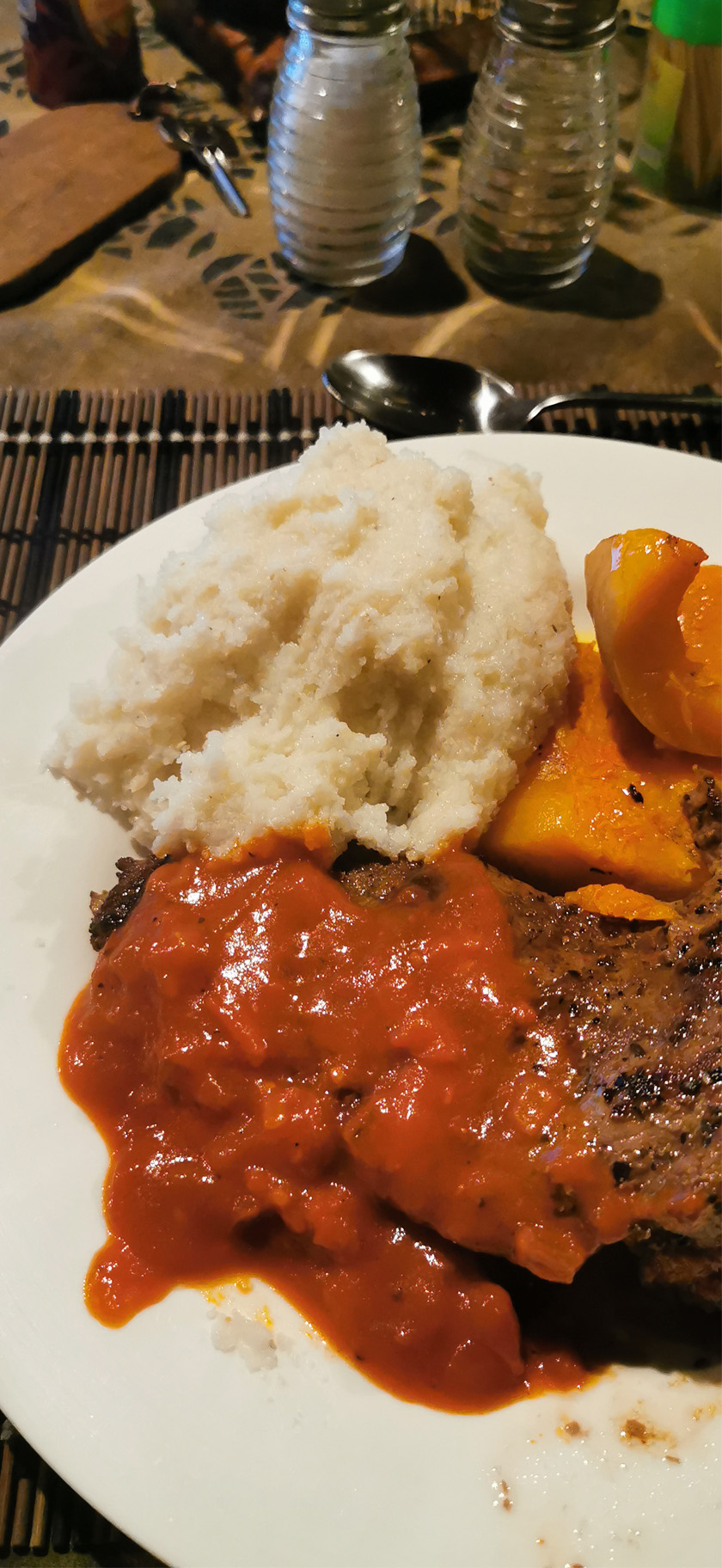Sadza

Sadza was such an important dish to my guide, Ndaba, while we were travelling through Zimbabwe that he consumed a plate full of it at just about every meal. One day, having replaced sadza during one of his meals with a pizza, he hopped on the very next opportunity to consume sadza and nothing else. Upon our arrival in Harare, the end of our journey, I promised him a meal at the restaurant of his choosing, where he could have anything he wished as my way of thanking him, and he enthusiastically chose sadza.
So what is sadza? Think about what rice means to a meal in China, or what potatoes represent to an Irishman, and you begin to get into sadza territory, but you’re still not really that close. Although no one I met ate sadza as often or as voraciously as Ndaba, it was the staple food on everyone’s plate from Tanzania, through Zambia, to Zimbabwe. Each country had its own name for it. In Zimbabwe it was sadza, but in Tanzania, it was ugalli and in Zambia they called it nshima.
Sadza is what most North Americans would call a side dish, but, in Africa, it is the focal point of the meal. Where I come from it’s common for people to order a meal and eat all of the meat and vegetables but leave some rice or boiled potatoes left over – it was never the case with sadza. In Africa, it wasn’t uncommon to see threads of meat still clinging to bones on a finished plate, but not a single drop of sadza left over.
 Similar in consistency and appearance to mashed potatoes, sadza is made from dried maize that has been ground into a fine meal and then boiled with water until it becomes thick and stiff like a hard porridge or dough. The easiest comparisons are to polenta but even that has a more distinct corn flavour and is more gelatinous in its consistency. Sadza, on the other hand, is essentially flavourless with no spices or herbs ever added and no salt or sugar either. The corn itself does not even contain that distinctive smell and flavour that you might recognize from a Mexican corn tortilla. It is eaten with the hands and occasionally mixed with a few drops of a tomato-based sauce similar to ketchup or with whatever sauce any of the other dishes may have been cooked in – but more often than not it is eaten au naturel.
Similar in consistency and appearance to mashed potatoes, sadza is made from dried maize that has been ground into a fine meal and then boiled with water until it becomes thick and stiff like a hard porridge or dough. The easiest comparisons are to polenta but even that has a more distinct corn flavour and is more gelatinous in its consistency. Sadza, on the other hand, is essentially flavourless with no spices or herbs ever added and no salt or sugar either. The corn itself does not even contain that distinctive smell and flavour that you might recognize from a Mexican corn tortilla. It is eaten with the hands and occasionally mixed with a few drops of a tomato-based sauce similar to ketchup or with whatever sauce any of the other dishes may have been cooked in – but more often than not it is eaten au naturel.
More than just ingesting sadza there is the near theatrical role that it plays as part of mealtime in the way that it is eaten with the hands and not utensils. Knives, forks, and spoons are at every place setting but washing hands to prepare and conclude the eating of sadza is an integral part of the dining ritual in southern Africa. When dining out, a waiter will come to the table holding a pitcher full of water, a washbasin, and a dispenser of liquid hand soap. No matter what you are eating, even if your hands are perfectly clean and you plan to use your utensils to eat, this ritual is observed before and after any meal. Even on trains, where basic amenities are in short supply, and water is at a premium for all manner of necessary ablutions, this mealtime observance seems to take precedence above all others.
To anyone unaccustomed to eating sadza, the first thing that you notice is that it is served hot. Very hot. Too hot to eat with one’s hands. Yet there is a rhythm and a dance in the way the locals grab small portions of it and roll it in their hands before they eat it. Ndaba could have his eyes totally fixed on me and could roll and eat sadza through sense of smell and touch. I, on the other hand, embarrassed myself every time I tried to eat it. I would drop pieces that were too hot to handle and, whereas the fine granules of the cornmeal that would stick in small clusters on a couple of Ndaba’s fingers and his palm, would find their way up my arm, into my lap, in my beard and in my hair. For Ndaba, washing up after eating sadza was a straight forward affair, but I would need to have a shower.
Although I ate sadza a few times, I never enjoyed it. Given a chance between it or potatoes or rice, or any other available starch, I would avoid the sadza. And, after a couple of embarrassing attempts at eating it with my hands, whenever I was served it I would eat it with a fork. From the standpoint of flavour, it offered me almost nothing but what felt like empty calories, which for a long time made me wonder why it was so beloved by the locals, but it probably had something to do with just that – calories.
Much maligned today in Europe and the Americas as one of the major contributing ingredients to the obesity epidemic because of its inclusion in most modern processed foods, the caloric punch that corn crops provide in a place like Zimbabwe is a godsend. In Zimbabwe, instead of making people fat, maize keeps people alive. In America, corn is heavily subsidized and shows up in various forms in all sorts of food from twinkies to coca-cola and has led health researchers to suggest that if you are what you eat, then Americans are mostly corn. Things, I imagine, aren’t much different in southern Africa, but the caloric density of a single kernel of corn packs so much punch per penny that it is relied upon for survival. You’re not likely to see sadza as the centrepiece of a dish at a Michelin-starred restaurant, but the truth is not everyone has the luxury of eating flavoured foam at one dollars per thimble. It may not look or taste like much, but sadza has saved lives. Every day in Zimbabwe, a plate of sadza fills the belly of someone in who’s meal tomorrow will also be sadza. And for every day that goes by and every plate of sadza that fills their belly, they are thankful.